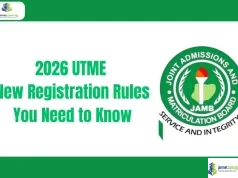A complete guide on how to pass the Post-UTME exam in 2026 on your first attempt. Learn proven tips, understand the exam format, and master the registration process.


Congratulations on passing your JAMB! Now, the next crucial step is mastering the Post-Unified Tertiary Matriculation Examination (Post UTME). This screening test is how universities select the most serious candidates for admission. Passing JAMB is a great start, but excelling in the Post-UTME is what truly secures your place in your dream school.

Join our Telegram Channel for Instant Scholarship Updates
While the exam might seem difficult, with the right strategy, you can score high and significantly boost your chances of gaining admission. This guide will provide you with a clear roadmap, from smart preparation to a successful application, ensuring you are ready to tackle the exam with confidence.
What is Post-UTME?
The Post-UTME is a screening test conducted by most Nigerian universities after the JAMB exam. It is a mandatory step for admission. The exam generally tests the same subjects as your JAMB, though some institutions may also include questions on current affairs or institution-specific knowledge.
The format can vary by university, with some schools using a Computer-Based Test (CBT) and others a Paper-Based Test (PBT). The duration is typically short, lasting between 30 minutes to an hour. To determine your final admission status, your Post-UTME score is combined with your JAMB score, and the result is measured against the cut-off mark for your chosen program.
How to Register for the Post-UTME Exam
Registration for the exam is handled individually by each university on its official portal. It is crucial to follow the correct process to avoid common mistakes.
Here are the general steps most universities follow for registration:
- Access the School’s Official Portal: Always start by visiting the university’s official website. Search for the school’s name on Google and verify that the website address ends with
.edu.ngto avoid fake websites. - Create an Account: The first step on the portal is usually to create a candidate account. This account will be your central point for registration and future updates. Use your correct details to avoid any errors.
- Fill Out the Application Form: After creating your account, carefully fill out the online form with all your personal information, including your JAMB registration number, chosen course of study, and contact details. Use a valid email address that you check regularly, as schools often send updates and exam information to this address.
- Upload Required Documents: You will be asked to upload scanned copies of documents in specific formats. These commonly include your O’Level results (WAEC/NECO), birth certificate or age declaration, and a passport photograph. Ensure your scans are clear and meet the specified size limits.
- Pay the Application Fee: Each university sets its own examination fees, typically between ₦2,000 and ₦5,000. Payment is usually done online through a secure platform linked on the official portal. Never pay into a personal bank account.
- Print Your Confirmation Slip: Once your application and payment are successful, the system will generate a confirmation or acknowledgment slip. This slip is essential—it is your proof of registration and will be required for gaining access to the exam venue. Save a digital copy and print a physical one for safety.
- Check Your Exam Date and Venue: After registration, regularly check the school’s portal and your email for your specific exam schedule. The exams are often conducted in batches, so your date and venue may differ from your friends’.
Understanding the Admission Formula
Admission is not solely based on your exam score. Most universities use an aggregate score that combines your JAMB and Post-UTME results. While the exact formula can vary, the most common weighting is 50% for your JAMB score and 50% for your Post-UTME score.
Here’s an example of how the aggregate score is calculated:
- Your JAMB score:
300 - Divide your JAMB score by 8:
300 / 8 = 37.5 - Your Post-UTME score:
60 - Your Aggregate Score:
37.5 + 60 = 97.5
Your final admission is then determined by comparing this aggregate score to the cut-off mark for your chosen course.
10 Proven Tips to Pass the Post-UTME Exam In One Sitting
Now that you know what the Post-UTME is and how to register, here are 10 proven tips to help you prepare and pass on your first attempt.
- Understand Your University’s Exam Format: Every university has a unique Post-UTME format. While many use CBT, some might have different sections. For example, some schools may have an oral interview, a practical test for technical courses, or a separate test for current affairs. Research your school’s official portal or check with recent aspirants to get a clear picture of what to expect.
- Set a High Target Score: Do not just aim to pass the cut-off mark; aim for a much higher score. For a course with a 60% cut-off, target 70% or more. This provides a safety margin and gives you a clear benchmark to work towards.
- Gather the Right Study Materials: Start with your school’s official past Post-UTME questions, as questions are often repeated. Supplement this with your JAMB textbooks and practice guides.
- Create a Study Schedule: A structured timetable is your best friend. Break your study time into daily sessions and focus more on your most difficult topics. Consistency is more effective than cramming.
- Revisit Your JAMB Notes: Think of the Post-UTME as a re-examination of your JAMB knowledge. Revising your JAMB notes, especially for your core subjects, will refresh your memory and give you a significant advantage.
- Read Consistently: Reading a little every day is the secret to strong retention. Mix up your study methods by using textbooks, online lessons, and group discussions to make the process more engaging.
- Time Yourself While Practicing: Post-UTME exams are short and fast-paced. Practice solving questions under timed conditions to improve your speed and accuracy. This will help you manage time effectively on the actual exam day.
- Strengthen Your Weak Areas: Do not ignore subjects you dread. Spend extra time on difficult topics, use online tutorials, and seek help from teachers or peers. Overcoming your weak areas can turn them into your greatest strengths.
- Stay Updated on Current Affairs: Many universities include general knowledge questions in their exams. Make it a habit to read newspapers and follow credible news sources to stay informed about Nigerian politics, history, and global events.
- Stay Healthy and Rested: Your physical and mental health are just as important as your preparation. Make sure to get enough sleep, eat balanced meals, and take breaks. A well-rested brain can recall information far more easily.
What to Do After the Exam
Your journey does not end when you submit your exam. Here are the crucial steps to take after the Post-UTME:
- Check Your Score: Your Post-UTME score is usually released on your school’s portal a few weeks after the exam. Make sure to check your score and save a screenshot or print it out.
- Wait for the Admission List: After all screening tests are concluded, the university will compile the scores and release the admission list. This list is the final indicator of whether you have been offered a spot. It may be released in batches, so do not be discouraged if you do not see your name on the first list.
- Monitor the School Portal: It is crucial to monitor the university’s official website and your personal portal regularly. All official communication, including admission lists, fee payment deadlines, and matriculation dates, will be posted there.
- Be Patient and Persistent: The admission process can be lengthy. Remain patient and avoid panicking or trusting unverified information from social media. Rely only on the official channels.
After you have completed these steps, you might start thinking about your future beyond your first degree. If you are interested in exploring scholarships to help fund your education, or even considering studying abroad, there are resources available to guide you. For example, you can learn about how to successfully apply for scholarships and discover how to win a fully-funded undergraduate scholarship. To strengthen your applications, you can also get tips on how to write a winning scholarship essay, an A-Z guide on explaining why you deserve a scholarship, and even advice on a Chevening scholarship essay.
Do not forget to understand the top qualities of scholarship winners and learn how to ask for a recommendation letter. If you are considering postgraduate studies abroad, you can discover the top 10 reasons to study your masters abroad and get tips on how to decide if studying abroad is for you. You can also find guides on navigating student loans, explaining a low GPA in your personal statement, and even how to apply for a post-graduation work permit. You can also find lists of affordable US universities and top universities in Australia. And once you are on your way, do not forget to check out these tips on student accommodation.
Frequently Asked Questions
What is the minimum score required to pass Post-UTME? There is no single minimum score. Every university sets its own cut-off mark for different courses. A good strategy is to aim for a score well above the general cut-off mark for your school.
Is the Post-UTME exam a CBT or PBT? The format depends entirely on the university. The majority of institutions now use a Computer-Based Test (CBT), but some still use a Paper-Based Test (PBT), so it is important to confirm your school’s specific format.
How long does the Post UTME exam last? The exam is typically short, lasting anywhere from 30 minutes to one hour, depending on the school and the number of questions.
What subjects are tested in the Post-UTME? The exam mainly tests the subjects related to your chosen course in JAMB. However, some universities may include a compulsory English language test or a section on current affairs.
Can I register for Post-UTME if I did not make the school my first choice? Some schools may not consider candidates who did not select them as their first choice. However, others may allow it if you apply for a change of institution. Always check the specific eligibility criteria on the school’s official portal.
How can I calculate my aggregate score? Most universities use an aggregate score that combines your JAMB score and your Post-UTME score. The most common formula is a 50/50 weighting, where your JAMB score is divided by 8 and added to your Post-UTME score.
How can I check my Post-UTME results? Results are typically published on the university’s official website or your personal candidate portal a few weeks after the exam. Make sure to have your JAMB registration number handy.
What documents do I need for registration? You will need your JAMB registration slip, O’Level results (WAEC/NECO), a birth certificate, and a recent passport photograph.
What is a good Post-UTME score? A “good” score is one that puts you well above the cut-off mark for your course. For competitive courses like medicine or law, a high score (80% or more) is often needed to guarantee admission.
What if I miss my exam date? If you miss your scheduled exam date, you will not be able to write the exam. It is crucial to check your date and venue well in advance and make sure you arrive early on exam day.













